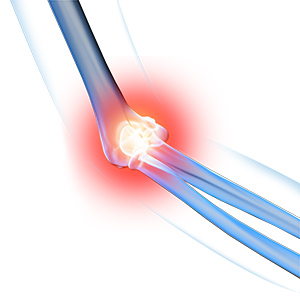
Elbow Anatomy
The elbow is a hinge joint made up of 3 bones: the humerus, radius, and ulna. The bones are held together by ligaments to provide stability to the joint. Muscles and tendons move the bones around each other and help in performing various movements. Nerves and blood vessels pass around the joint.
What is Elbow Pain?
Damage to any of the structures that make up the elbow joint can cause elbow pain.
What are the Common Causes of Elbow Pain?
The common causes of elbow pain may include:
Elbow dislocation: An elbow dislocation occurs when the bones that make up the joint are forced out of alignment as when you fall onto an outstretched hand. They can also occur from any traumatic injury such as a motor vehicle accident. When the elbow is dislocated you may experience severe pain, swelling, and lack of ability to bend your arm.
Elbow fractures: A fracture is a common injury to the elbow. Elbow fractures may result from a fall onto an outstretched wrist, direct impact to the elbow or a twisting injury. Elbow fractures may cause severe pain, swelling, tenderness, and difficulty in movement. If a fracture is suspected, assessment by your doctor is necessary. Surgery may be required if a bony displacement is observed.
Tennis elbow/golfer's elbow: Tennis elbow and golfer’s elbow are both painful conditions caused by irritation and/or degeneration of the tendons originating from the sides of the elbow. Overuse of the arms or a traumatic blow to the hand may cause tennis elbow or golfers elbow. These injuries may cause severe pain and tenderness of the affected muscles that radiate down into the forearm, particularly with use of the hand and wrist.
Adequate rest and modification of activities help the muscles to recover and allow for healing. A tennis elbow strap may relieve the pressure from the site of tendon attachment. A wrist brace may also limit aggravation of the involved area at the elbow. Anti-inflammatory medications may be recommended to relieve pain and inflammation. Heat therapy, followed by stretching and strengthening exercises and ice massage may be beneficial.
Tendonitis: Tendonitis is inflammation of any of the tendons of the forearm or wrist. It is usually treated with adequate rest, splinting, ice application and non-steroidal anti-inflammatory medicines to reduce the inflammation.
Any problem causing pain, swelling, discoloration, numbness, or a tingling sensation, or abnormal position of the elbow that persists for more than two or three days should be evaluated by your doctor to establish the cause and obtain the best treatment.
Related Topics
- Triceps Injuries
- Osteochondritis Dissecans of the Capitellum
- Elbow Trauma
- Elbow Arthritis
- Bicep Tendon Tear at the Elbow
- Elbow Dislocation
- Triceps Tendonitis
- Elbow (Olecranon) Bursitis
- Elbow Sprain
- Tennis Elbow
- Golfer's Elbow
- Little League Elbow
- Nursemaid's Elbow
- Elbow Pain
- Elbow Contracture
- Distal Humerus Fractures of the Elbow
- Radial Head Fractures of the Elbow
- Elbow Fractures
- Ulnar Nerve Neuropathy
- Loose Bodies in the Elbow
- Radial Tunnel Syndrome
- Lateral Ulnar Collateral Ligament Injuries (Elbow)
- Post-traumatic Stiffness (Elbow)
- Cubital Tunnel Syndrome (Ulnar Nerve Entrapment)





